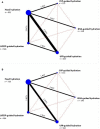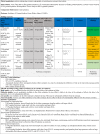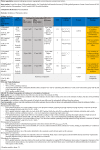Tailored Versus Standard Hydration to Prevent Acute Kidney Injury After Percutaneous Coronary Intervention: Network Meta-Analysis
- PMID: 34169747
- PMCID: PMC8403299
- DOI: 10.1161/JAHA.121.021342
Tailored Versus Standard Hydration to Prevent Acute Kidney Injury After Percutaneous Coronary Intervention: Network Meta-Analysis
Abstract
Background Contrast-induced acute kidney injury (CI-AKI) is a serious complication after percutaneous coronary intervention. The mainstay of CI-AKI prevention is represented by intravenous hydration. Tailoring infusion rate to patient volume status has emerged as advantageous over fixed infusion-rate hydration strategies. Methods and Results A systematic review and network meta-analysis with a frequentist approach were conducted. A total of 8 randomized controlled trials comprising 2312 patients comparing fixed versus tailored hydration strategies to prevent CI-AKI after percutaneous coronary intervention were included in the final analysis. Tailored hydration strategies included urine flow rate-guided, central venous pressure-guided, left ventricular end-diastolic pressure-guided, and bioimpedance vector analysis-guided hydration. Primary endpoint was CI-AKI incidence. Safety endpoint was incidence of pulmonary edema. Urine flow rate-guided and central venous pressure-guided hydration were associated with a lower incidence of CI-AKI compared with fixed-rate hydration (odds ratio [OR], 0.32 [95% CI, 0.19-0.54] and OR, 0.45 [95% CI, 0.21-0.97]). No significant difference in pulmonary edema incidence was observed between the different hydration strategies. P score analysis showed that urine flow rate-guided hydration is advantageous in terms of both CI-AKI prevention and pulmonary edema incidence when compared with other approaches. Conclusions Currently available hydration strategies tailored on patients' volume status appear to offer an advantage over guideline-supported fixed-rate hydration for CI-AKI prevention after percutaneous coronary intervention. Current evidence suggests that urine flow rate-guided hydration as the most convenient strategy in terms of effectiveness and safety.
Keywords: contrast‐induced acute kidney injury; coronary angiography; hydration; percutaneous coronary intervention.
Conflict of interest statement
Dr Brilakis reports consulting/speaker honoraria from Abbott Vascular, American Heart Association (
Figures





Similar articles
-
Prevention of Contrast-Induced Acute Kidney Injury by Furosemide With Matched Hydration in Patients Undergoing Interventional Procedures: A Systematic Review and Meta-Analysis of Randomized Trials.JACC Cardiovasc Interv. 2017 Feb 27;10(4):355-363. doi: 10.1016/j.jcin.2016.11.006. JACC Cardiovasc Interv. 2017. PMID: 28231903
-
Preventive Strategies for Contrast-Induced Acute Kidney Injury in Patients Undergoing Percutaneous Coronary Procedures: Evidence From a Hierarchical Bayesian Network Meta-Analysis of 124 Trials and 28 240 Patients.Circ Cardiovasc Interv. 2017 May;10(5):e004383. doi: 10.1161/CIRCINTERVENTIONS.116.004383. Circ Cardiovasc Interv. 2017. PMID: 28487354
-
Intravenous magnesium sulphate and sotalol for prevention of atrial fibrillation after coronary artery bypass surgery: a systematic review and economic evaluation.Health Technol Assess. 2008 Jun;12(28):iii-iv, ix-95. doi: 10.3310/hta12280. Health Technol Assess. 2008. PMID: 18547499
-
Systemic pharmacological treatments for chronic plaque psoriasis: a network meta-analysis.Cochrane Database Syst Rev. 2021 Apr 19;4(4):CD011535. doi: 10.1002/14651858.CD011535.pub4. Cochrane Database Syst Rev. 2021. Update in: Cochrane Database Syst Rev. 2022 May 23;5:CD011535. doi: 10.1002/14651858.CD011535.pub5. PMID: 33871055 Free PMC article. Updated.
-
Periprocedural effects of statins on the incidence of contrast-induced acute kidney injury: A systematic review and trial sequential analysis.Int J Cardiol. 2016 Mar 1;206:143-52. doi: 10.1016/j.ijcard.2016.01.004. Epub 2016 Jan 8. Int J Cardiol. 2016. PMID: 26797158
Cited by
-
Management Considerations for Acute Coronary Syndromes in Chronic Kidney Disease.Curr Cardiol Rep. 2024 May;26(5):303-312. doi: 10.1007/s11886-024-02039-0. Epub 2024 Mar 7. Curr Cardiol Rep. 2024. PMID: 38451453 Review.
-
Perioperative Acute Kidney Injury: Diagnosis, Prediction, Prevention, and Treatment.Anesthesiology. 2025 Jan 1;142(1):180-201. doi: 10.1097/ALN.0000000000005215. Anesthesiology. 2025. PMID: 39527650 Free PMC article.
-
The High-Sensitivity C-Reactive Protein to High-Density Lipoprotein Cholesterol Ratio and the Risk of Contrast-Induced Acute Kidney Injury in Patients Undergoing Percutaneous Coronary Intervention.Rev Cardiovasc Med. 2024 Sep 23;25(9):338. doi: 10.31083/j.rcm2509338. eCollection 2024 Sep. Rev Cardiovasc Med. 2024. PMID: 39355575 Free PMC article.
-
Cost-Effectiveness of Team-Based Coaching With Surveillance for Prevention of Acute Kidney Injuries.JAMA Netw Open. 2025 Apr 1;8(4):e252503. doi: 10.1001/jamanetworkopen.2025.2503. JAMA Netw Open. 2025. PMID: 40172890 Free PMC article.
References
-
- Tsai TT, Patel UD, Chang TI, Kennedy KF, Masoudi FA, Matheny ME, Kosiborod M, Amin AP, Messenger JC, Rumsfeld JS, et al. Contemporary incidence, predictors, and outcomes of acute kidney injury in patients undergoing percutaneous coronary interventions: insights from the NCDR Cath‐PCI registry. JACC Cardiovasc Interv. 2014;7:1–9. - PMC - PubMed
-
- Valle JA, McCoy LA, Maddox TM, Rumsfeld JS, Ho PM, Casserly IP, Nallamothu BK, Roe MT, Tsai TT, Messenger JC. Longitudinal risk of adverse events in patients with acute kidney injury after percutaneous coronary intervention: insights from the National Cardiovascular Data Registry. Circ Cardiovasc Interv. 2017;10:e004439. DOI: 10.1161/CIRCINTERVENTIONS.116.004439. - DOI - PubMed
-
- Almendarez M, Gurm HS, Mariani J, Montorfano M, Brilakis ES, Mehran R, Azzalini L. Procedural strategies to reduce the incidence of contrast‐induced acute kidney injury during percutaneous coronary intervention. JACC Cardiovasc Interv. 2019;12:1877–1888. DOI: 10.1016/j.jcin.2019.04.055. - DOI - PubMed
-
- Wohlin C, ACM (Association for Computing Machinery) . Guidelines for snowballing in systematic literature studies and a replication in software engineering. Proceedings of the 18th International Conference on Evaluation and Assessment in Software Engineering. New York, NY: Association for Computing Machinery; 2014: 1–10. DOI: 10.1145/2601248.2601268. - DOI
-
- Hutton B, Salanti G, Caldwell DM, Chaimani A, Schmid CH, Cameron C, Ioannidis JPA, Straus S, Thorlund K, Jansen JP, et al. The PRISMA extension statement for reporting of systematic reviews incorporating network meta‐analyses of health care interventions: checklist and explanations. Ann Intern Med. 2015;162:777–784. DOI: 10.7326/M14-2385. - DOI - PubMed
Publication types
MeSH terms
Substances
LinkOut - more resources
Full Text Sources

